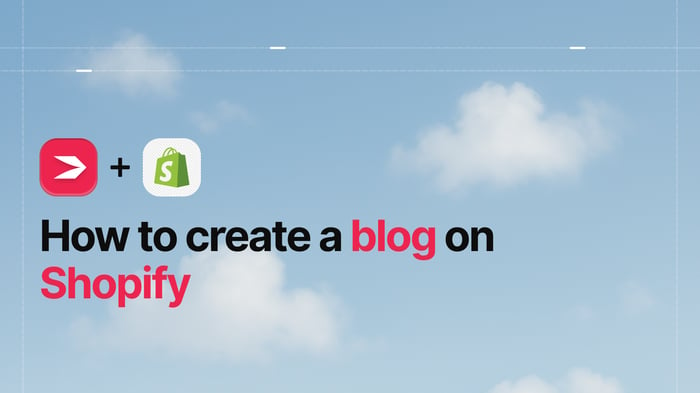Shopify has been such a popular e-commerce platform for so long that its name has become virtually synonymous with e-commerce. And, of course, the main reason for its undeniable success is the fact that it can be monetized. Considering all the success stories, it’s no wonder that more and more e-commerce enthusiasts want to try out the platform and learn how to make money on Shopify.

In this guide, we’ll explore some of the best and most recommended methods people use to make money on Shopify. We’ll explain some key terms and concepts, give you a few tips, and suggest general guidelines on what you can try to monetize Shopify. So, without further ado, let’s get straight to our topic.
Table of Contents
The Most Popular Methods to Make Money on Shopify
Before we dive into the specifics of different earning methods and techniques, let’s first go over the two most popular methods entrepreneurs and e-commerce enthusiasts have used to rake it in on Shopify.
Literally, wherever you look when researching our topic, you’ll find two recurring themes: dropshipping and affiliate marketing. At times, it seems like these two are more popular ways of monetizing Shopify than building and running standard e-commerce storefronts. Thinking about it, it’s not that hard to figure out why:
- Affiliate marketing and dropshipping require the least investment – in certain scenarios, you can do both almost without spending a dime upfront.
- They’re both pretty much risk-free, although that is most true with affiliate marketing; if you fail to make a profit, you’ll lose very little, or sometimes next to nothing, so you won’t suffer any serious personal financial damage.
- It doesn’t take extreme effort to be able to capitalize on dropshipping and affiliate marketing, at least not as much as when you’re running a full-fledged e-commerce business.
- You can do them both without having highly developed technical skills or expertise.
Now, we might have exaggerated a bit and made affiliate marketing and dropshipping sound like the simplest and easiest things in the world to do. Well, as you’ll soon see, that’s not quite the case. However, compared to creating and running a Shopify store and some other ways of using Shopify, these two are pretty safe and easy to do.

That said, considering affiliate marketing and dropshipping as potential revenue streams, don’t expect to sit with your hands crossed, waiting for something to fall from the sky. You’ll still need to roll up your sleeves and do some work. However, if you’re just starting out and are looking for something that’s not that risky and/or don’t have a big budget for side projects, then your best bets are these two methods, as well as building a print-on-demand store, which we’ll get to later on in the article.
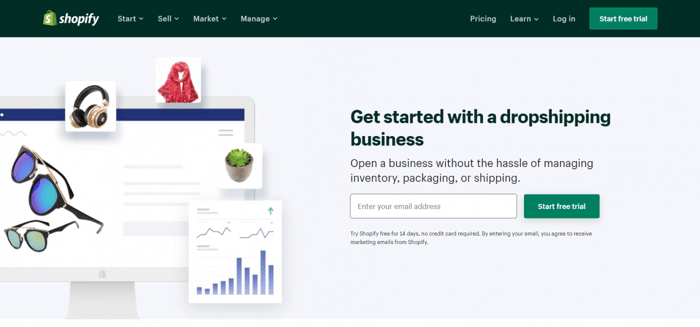
First, let’s start with and explain the Shopify affiliate marketing program.
Affiliate Marketing Program
In an interesting Shopify blog post, affiliate marketing is called a “distinctly 21st century form of entrepreneurship,” and we tend to agree with this. It’s a special risk-free way of doing online business that’s completely in line with our contemporary mentality. It has been growing in popularity for a while and, at this point, it looks like this trend won’t stop any time soon. As a matter of fact, predictions are that affiliate marketing will become an $8.2 billion industry by 2022.
So, what is affiliate marketing?
What Is Affiliate Marketing?
In simple words, affiliate marketing means promoting a certain platform, company, or brand in return for monetary compensation. When you sign up for an affiliate program, the company sends you a unique referral link. Your job then is to recommend the company to as many other users as possible, offering them the opportunity to sign up for a trial through your link. When someone clicks, signs up for the trial, and proceeds with a paid subscription after the trial ends, you get a commission for your promotional efforts. Depending on the company and how popular it is, you can earn pretty good money as an affiliate.
What Do You Need to Join the Shopify Affiliate Program?
When it comes to affiliate marketing, Shopify has managed to build a very successful program that has become extremely popular and appealing to many e-commerce enthusiasts mostly due to its generous nature. But first things first. No matter how simple and easy affiliate marketing sounds, at least as far as Shopify is concerned, there are some criteria that you need to meet to participate in the Shopify affiliate program.

Becoming a Shopify affiliate is free and anyone is welcomed to apply to join, but according to Shopify’s official information, it seems that not everyone can become one. The requirements you need to fulfill to start doing affiliate marketing on probably the most popular e-commerce platform ever are the following:
- You need to have an active website.
- You have to already have at least some steady audience. A huge existing following on social media and similar channels is a big plus as well.
- You need to have original content on your site, like blog posts, courses, YouTube videos, and so on.
- You need to have some experience with Shopify or other e-ecommerce platforms.
- Finally, it goes without saying that you need to accept Shopify’s terms and conditions.
When you think about it, looking at things from the perspective of a super-successful company like Shopify, these criteria make sense. To have a website or blog with original content shows that you’ve already worked out ways to promote not just yourself, but Shopify as well. After all, without this, where would you promote Shopify?
It’s a similar rationale with the audience/following requirement. To whom will you promote Shopify if you haven’t managed to build an audience on your website, on YouTube, or on one of the social media platforms? It’s also reasonable to expect more success in terms of promotion when you already know a thing or two about Shopify or e-commerce in general. In short, all these criteria serve as a certain safeguard – a guarantee that Shopify will extend its reach even further and make more profits through your promotional efforts.

What Happens After You Join?
Let’s say you’ve set up a Shopify affiliate account and sent your application. What’s next?
Usually it takes up to 15 days for Shopify to review and answer if your application was approved. In case it wasn’t, you won’t get any reply. Shopify cites the high number of submissions as a reason for not answering the denied applications.
If you’re among the lucky selected affiliates, you’ll receive an email along with the aforementioned unique referral link. Additionally, you'll find the referral link in the "Affiliate tools" section of your Shopify account as well.
On top of this, since Shopify wants to be sure that you’ll be successful as an affiliate, for your own sake as well as the company’s, it’ll provide you with some tools that allow you to get the show on the road. So, when you become an affiliate, you get access to a dashboard where you can track stats related to your affiliate efforts – user identity, total revenue, when someone became a paid customer, etc.– and resources whose purpose is to fully equip you for success.
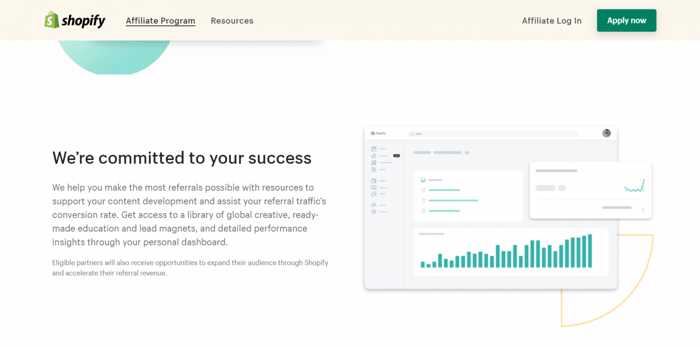
There are a few things you need to know when you become a Shopify affiliate:
- You have to have a PayPal account. Currently, that’s the only way to get a payout. So, if you reside in one of the countries where for some reason PayPal doesn’t work or works only in one direction (you can pay, but not receive any payments), this is a huge bummer.
- There are programs that include commission for other types of user engagement, but someone becoming a customer (after signing up for a 14-day free trial) is the one and only prerequisite for commission on Shopify.
- There’s no cap on the number of users you can refer to Shopify.
- You’ll be assigned an Affiliate Manager to help you resolve any issues that come up along the way.
When Do You Receive Your Payout?
Shopify is big, so it’s affiliate program is big on generosity as well. The company offers good returns on the affiliate program. As often reported, Shopify affiliates get $58 for every new signup, which is a pretty generous commission.
As of now, Shopify pays its affiliates twice a month. The payout for the first half of the month is five days after the 15th (20th). Payout for the second half of the month is five days after the end of the month (5th of next month).
However, keep in mind that if your balance is less than $25 for these periods, you’ll get paid on the next payout day. Say your balance is $20 for the first half of the month; you won’t receive anything on the 20th. Assuming your balance increases in the meantime, you’ll get paid on the 5th of next month.
How to Promote Shopify
We already mentioned a few ways you can promote Shopify, but let’s go more in depth with this topic.
Sites, Workshops, Tutorials, Podcasts, and Courses
One of the things you can do is create workshops and tutorials and include your referral link somewhere in the content. If you already have a website that you took the time to work on, that’s a great place to promote Shopify. The same applies to podcasts and courses.
YouTube
Uploading videos with relevant content on YouTube is one of the best and highly recommended ways to promote Shopify and get people to click on your affiliate link. As a matter of fact, we know for sure that the majority of people we know, including ourselves, head to YouTube first to gain some quick knowledge on any possible topic out there. It’s super-convenient and the best part is that it allows you to learn audio-visually, which comes in very handy, regardless of how much you like reading.
Just pick a topic that’s massively popular in terms of keyword searches, such as “how to” or “this vs. that platform,” but remember to add a twist – put something interesting in the title that makes your video stand out from the competition. As long as it's enticing enough and not overly generic, it should do the trick.
For instance, “What Is Shopify?” would probably be a bad idea since it’s an overexploited topic that would make your video get lost in the sea of a gazillion similar titles. And one more thing: do not make your video too long. Unless it is a Call of Duty gameplay walkthrough, you won’t find many people interested in spending half an hour on a YouTube video.
Pinterest is another channel that you can use to promote Shopify. For instance, as some experienced affiliates suggest, just by putting pins that lead to your blog posts you can get more traffic and increase your chances of people signing up through your promotional efforts.
Blog
Speaking of blogging, it’s one of the best ways to make money as a Shopify affiliate and beyond that. Blogging is a source of traffic, which means more possibilities for Shopify signups through your affiliate link. It goes without saying that your posts should be related to Shopify directly or indirectly. In any case, they need to leave enough room for you to put a link to Shopify without you being too pushy and sounding too salesy and unnatural.
Shopify gives you an opportunity to blog with its native built-in blogging app available out of the box.
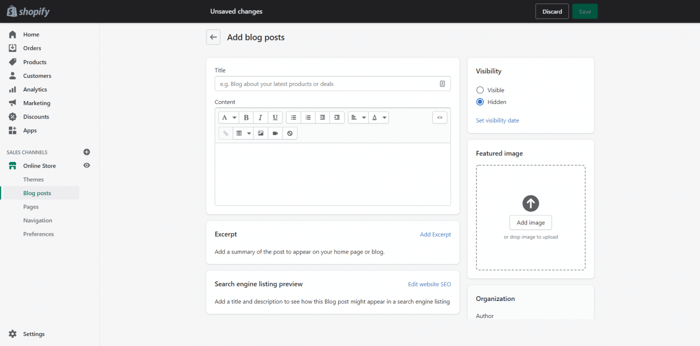
It’s a decent app and you can use it for promotional purposes. However, keep in mind that it was not built for serious content marketing.
Luckily, as you might have guessed, Shopify boasts a huge ecosystem of apps, some of which let you add a functionality like blogging.

As an illustration, one such app is DropInBlog. It was built strictly for blogging and content marketing. Unlike the built-in Shopify blog, this is a fully featured and hence much more powerful blogging app that’s meant to provide you with all the necessary features and then some for heavy blogging and extensive content marketing. In case you already have a Shopify account and want to find out how DropInBlog works with Shopify, you can take a look at these resources.
Clearly, this is not an exhaustive list of all the possible ways to promote Shopify as an affiliate, but currently these are some of the most popular methods that content and course creators, influencers, and even review sites use to promote Shopify.
Shopify Partners
A standard affiliate program is not everything that Shopify offers. There’s another, somewhat more advanced, possibility for experienced and proven Shopify customers and affiliates. It’s called Shopify Partner Program.

Experienced affiliates constantly remind us that the affiliate status is not to be reduced to just receiving commissions. They claim that, as Shopify partners, Shopify helped them with their own business ventures on the e-commerce platform in many tangible ways, such as by providing additional resources and tools relevant to what they were doing before to become even more successful.
When successful and experienced affiliates become verified Shopify partners, they establish themselves as Shopify authorities, which helps them gain more customers in the context of their own businesses. Every Shopify partner emphasizes the additional benefits that you experience as a member of the Partner program that go beyond the affiliate commission, no matter how generous it is.
The status of a partner extends what you get as an affiliate and opens up a new window of opportunities, such as:
- A chance to collaborate with the company and create content like blog posts and videos for Shopify itself.
- A possibility to offer your design, development, and marketing skills to other Shopify customers in the Experts Marketplace.
- An opportunity to help other users migrate from another e-commerce platform to Shopify.
- A chance to sell your apps and designs in the Shopify App Store and Shopify Theme Store.
- Early access to new Shopify features.
On top of all this, Shopify allows you to add the Shopify Partner branding on your Shopify site, which can be of tremendous help for your own business. The Shopify Partner branding is a confirmation for your audience and customers that they’re dealing with someone who is in the know; it helps you build stronger authority, credibility, and trust. Essentially, with the Partner Program, Shopify endorses you, which, as you can imagine, is not a small thing to achieve.
Similar to the Affiliate program, the Shopify Partner program is open for everyone and it’s free to apply and join this initiative. And when it comes to how much Shopify partners earn, check out this Shopify resource. Also, for more information on the Shopify Partner program as well as some other opportunities that you can take advantage of as a Shopify affiliate, check out the Shopify documentation.
Conclusion
Becoming a Shopify affiliate makes so much sense, as the perks that we talked about in this section clearly show. Indeed, there are some eligibility requirements in place, but they should not discourage you from trying to join. While doing our research, we came across examples of successful Shopify affiliates who started modestly, but over time managed to turn their status of affiliate not just into a source of money on the side, but into a source of high income.
Shopify is one of the most popular, if not the most popular, e-commerce platform globally, and it’s constantly growing. There are so many people already wanting to become a part of this phenomenon. On the one hand, this is a far cry from the hardest job in the world, but on the other, it presupposes at least some activity and initiative on your part. But that’s the whole point, isn’t it? After all, you are an affiliate marketer, the emphasis being on marketer.
Dropshipping
Dropshipping is the other hottest topic on the subject of how to make money on Shopify. This concept can sound confusing, but in reality it’s a rather simple idea that’s not hard to grasp and implement. Let’s see what it is.
What Is Dropshipping?
Simplified, dropshipping boils down to selling products that someone else is manufacturing and selling them for a higher price than the original on your Shopify store. So, when a customer buys a product from you, you pay the original seller the lower price and earn money on the price difference between yours and original price without even being the one who ships the product to the buyer. The original seller sends the product to your customer.
In this scenario, you don’t need to care about packaging, inventory, or shipping. Dropshipping doesn’t require you to create, buy, or store your products. Literally everything else but the sale itself is done by others. So, to do dropshipping means to “outsource the fulfillment and shipping” and still make profits from sales.
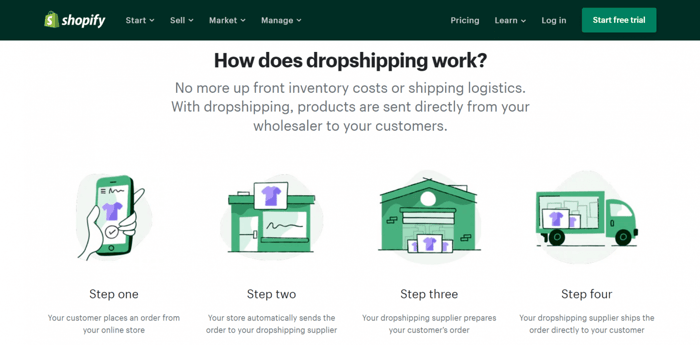
Another great thing about dropshipping is that it doesn’t require you to pay for the products you offer until a customer places an order. It’s only after the order’s been placed that you need to pay for the products you’re selling. Clearly, as we mentioned before, this is extremely low-risk of doing e-commerce in terms of investing and losing money. The worst thing that can happen is a customer who’s not satisfied with the product and wants to return it. But even in a situation like this, there are probably ways to get at least part of the money you return to your customer from the original seller.
To a certain extent, dropshipping democratizes e-commerce. You don’t need a big budget to start out in this area and it’s not as difficult as running a full-fledged e-commerce business, so virtually anyone can (try to) do it. Most probably, this is why it’s one of the top recommended ways to make money on Shopify.
Dropshipping on Shopify
To get started with dropshipping on Shopify, you only need three things:
- A Shopify account
- A product supplier
- A product
That’s it. However, regardless of how simple this sounds, it may take some time to find the perfect product to sell – meaning a product or products that people would want to buy specifically from you – and a supplier to cooperate with.
Product Supplier
The majority of people who do dropshipping on Shopify use one of the following three channels to find a product supplier:
- AliExpress
- Alibaba
- eBay
It seems that out of these three, AliExpress has been the most popular for a long while, but things are starting to change. Instead of AliExpress, some Shopify entrepreneurs have started to recommend Alibaba and eBay as better solutions.
The biggest advantage of Alibaba is that it allows you to cooperate directly with the companies that manufacture products. This means that you’ll pay less, sometimes significantly less, for the products because you remove the middleman from the equation – in this case AliExpress. Alibaba allows you to get the optimal prices and order in bulk.
However, there’s one more piece to the puzzle that you’ll need to take care of when cooperating with product suppliers from Alibaba: agents. An agent is someone who negotiates a deal for you directly with the suppliers, so it’s almost certain that you’ll have to find one to communicate with product suppliers on your behalf.
If you can find a product supplier with whom you can strike a good deal, eBay is an excellent option, especially for US-based entrepreneurs. One of the biggest problems with an AliExpress product supplier is the long delivery wait. eBay removes this hurdle by significantly shortening the delivery time.
Wherever you get your products, your dropshipping business comes down to: someone else providing everything (products, storage, and shipping), but it’s on you to do the marketing and customer management.
Product
There aren’t hard-and-fast rules on what product/products to sell. It’s something you’ll have to figure out for yourself. A lot depends on your target audience. As some Shopify dropshipping entrepreneurs recommend, you should first find your audience and only then the product for that particular audience, not the other way round.
As far as whether you should sell one or multiple types of products, focusing on one or as few as possible products is the most advisable option. It shows a focus and creates certain expectations with your audience. Besides, a store that sells laptops, dog food, and inflatable water pools at once just doesn’t seem right – it leaves the impression that something is off, maybe even fishy.
We can’t recommend exactly what products to sell, but we can help with some information on what’s been working in 2021. According to a Shopify article, the following is a list of some of the most profitable dropshipping niches and types of products in 2021:
- Health and personal care
- Gaming
- Car accessories
- Office products
- Camera and cellphone accessories
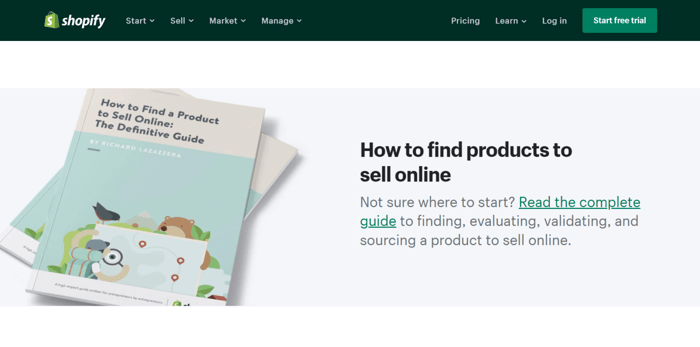
One of the biggest advantages of dropshipping is that it enables you to test what works and what doesn’t without going through significant losses and turmoil. This especially applies to your search for the right product. You can test several different products without big losses. It may take some time and trial and error, but in the end, we’re sure you’ll be able to find a product that appeals to your target audience.
You can start with a small number of items, just so you see if there’s anyone willing to pay for them. If you sell a few, that’s a good sign that you can continue selling that specific product.
Oberlo
When it comes to products and product suppliers, there’s a dropshipping app that does a great job in providing you assistance with your search for that ideal product and product supplier. It’s name is Oberlo, it includes a free plan, and it’s available for install on Shopify.
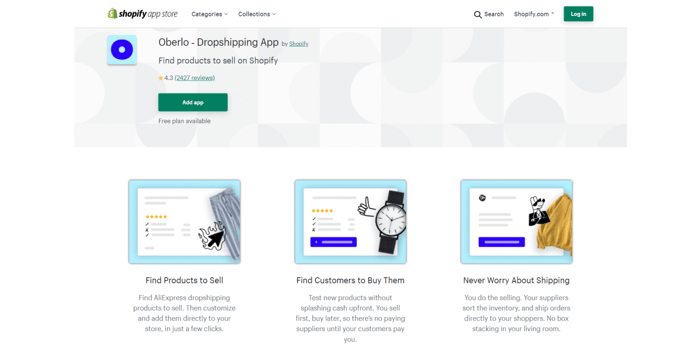
Oberlo is called a “dropshipping marketplace and toolkit” and “virtual warehouse.” It provides you with invaluable information and analytics on myriads of suppliers’ products, which helps you to choose the right product for your dropshipping business.
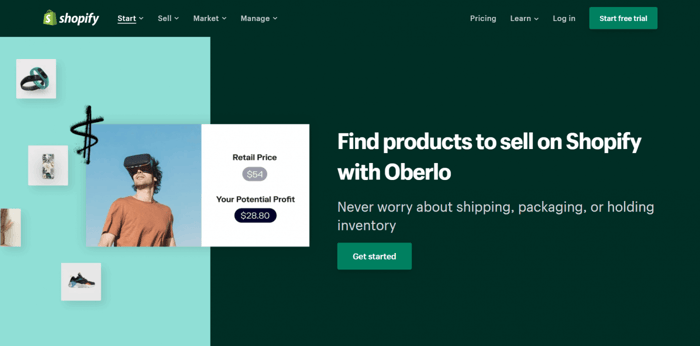
Oberlo is connected with AliExpress from where it allows you to import any products you want to your Shopify store in a matter of minutes. In addition to helping you find products, it allows you to make edits and display the products with your branding in your store as well as lets you know whether a product is still available or out of stock. Oberlo even adds your buyers’ orders to the AliExpress shopping cart, proceeds to the checkout page, and automatically enters the necessary buyers’ information. Your job is only to confirm the order.
So, if you opt for making money on Shopify through dropshipping, you may want to consider adding Oberlo to Shopify and taking advantage of all the perks that this app brings to dropshipping businesses around the world.
Branded Dropshipping
Some e-commerce entrepreneurs argue that standard dropshipping cannot work well any more. Instead, they think that branded dropshipping is a more suitable option in the current conditions and they have already made the shift toward this type of dropshipping themselves.
What is branded dropshipping and how does it differ from the standard dropshipping?
As its name clearly suggests, branded dropshipping puts emphasis on building your own distinctive brand and stronger brand awareness. You need to find a product that sticks out from everything else that’s being offered and attracts people’s attention. Finding that product is one of the most important, and at the same time most difficult, aspects of branded dropshipping.
So, when you manage to find it, you need to concentrate exclusively on selling just that one product that works. In time, you may try selling a few other products, but they all need to be closely related.
Since your dropshipping business will revolve around your brand, you need to create a memorable logo and put your logo on all of the products you sell as well as the packages your products are shipped in.
The next key thing is to focus on aesthetics and overall good customer experience. This requires beautifully designed products and packaging as well as a professionally looking e-commerce store and a matching sales page. Your customers deserve an uninterrupted good visual experience, and that’s what you need to provide.
In addition to this, since marketing plays a very prominent role in dropshipping, you need to work on ads that answer the question: what problem does my product solve? Your ads also need to include a call to action, so after they learn about the products you’re selling, users are prompted to take that extra step and convert into customers.
Speaking of marketing, promotion through content creation can be of tremendous help as well. Blogging, video creation, and other original content can boost traffic, bring you new leads, and lead to higher conversion rates. To expand your reach, you can also try advertising and selling your store products on social media, like Instagram and Facebook.
In addition to this, some entrepreneurs suggest that you find a product supplier on Alibaba rather than AliExpress. Alibaba is cheaper, yet it offers a lot of opportunities. One of them is product customization. Alibaba allows you to have your company’s logo on your packaging as well as the products you sell. It also lets you communicate directly with product manufacturers and establish a long-term relationship of trust, which can greatly facilitate the process of turning third-party products into your own recognizable branded products.
So, essentially, the key difference between the standard and branded dropshipping is in the emphasis on brand building and everything that brand building entails.
Pros and Cons
We already talked about many pros of doing dropshipping. In addition to those, the following are two more upsides of dropshipping that come to mind:
- Due to the nature of dropshipping, you can sell products on the global market, not just locally. According to Shopify, there are a lot of suppliers that provide warehousing and fulfillment across the globe.
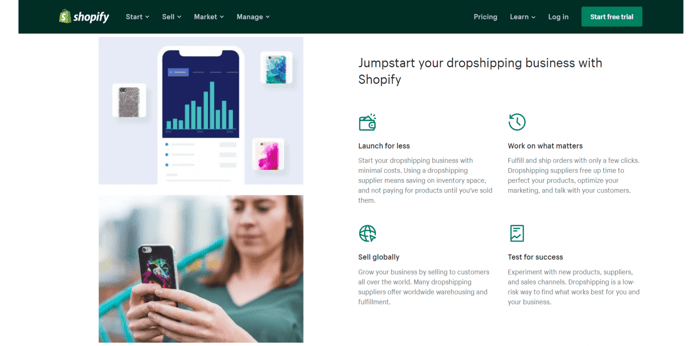
- According to Shopify, a lot of thriving dropshipping businesses are home-based. This only shows how convenient and money-saving a dropshipping business can be.
The following is a list of some cons of dropshipping:
- In the experience and opinion of some Shopify customers, dropshipping is only good for someone who is just starting out, but not as a long-term project with scaling up in mind.
- Bad customer experience due to slow shipping and no quality control is one of the biggest pain points that plagues dropshipping businesses. This results in dissatisfied customers, bad reviews, and bad reputation, which can prevent your business from taking off.
- Since a dropshipping business doesn’t include high costs, more and more people are doing it, which can result in very low prices. If you have to compete with gazillions of similar businesses, it’s only natural to resort to the tactics of lowering your prices. Low prices may give you an edge over competition, but in that case you won’t be able to gain significant profits.
- Lack of control is another huge problem. You control a very small fraction of your business, so that sometimes even the most fundamental aspects of doing business, like product quality control, stock levels, timely shipping, and good packaging, are not in your hands.
Print-on-Demand Store
In addition to becoming an affiliate and starting a dropshipping business, you can make money on Shopify by building a print-on-demand store. For this, you’ll need a third-party print service provider, like Printful. Printful integrates seamlessly with Shopify and it allows you to print, pack, and ship the products you sell via their services.
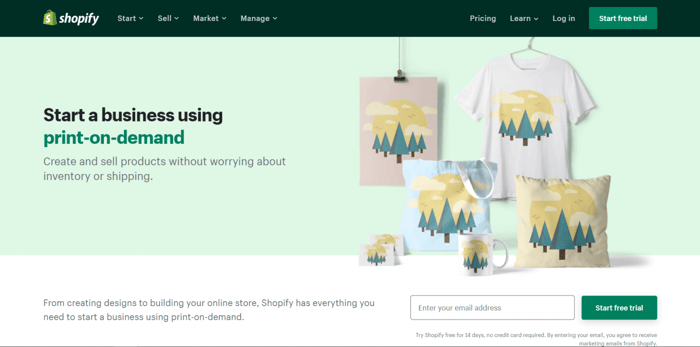
From the description above, it’s clear that print-on-demand e-commerce resembles dropshipping. A third-party company provides everything you need, so you don’t have to set aside a budget for storage fees, worry about inventory, or take care of shipping.

A great advantage of a print-on-demand business are the low upfront costs. Another upside is that you can sell almost wherever you want across the globe. Yet another is that you can take risks with new lines, designs, and products without being afraid of big losses.
A print-on-demand business allows you to print calendars, T-shirts and other clothing, accessories, blankets, drinkware, and more. Whatever you decide to sell, the best thing is that, essentially, you’ll be selling custom-made products that carry your logo. On the other hand, probably the biggest downside is the fairly slow shipping time.
In addition to Printful, which is probably the most famous of all, there are other similar companies whose apps integrate with Shopify. The following is a list of some of the most notable among them:
- Printify
- SPOD
- Apliq
- T-Pop
- CustomCat
Do your research, see which one suits your expectations best, build your uber-cool Shopify print-on-demand store, and get ready to embark on a memorable trip into the world of print-on-demand e-commerce.
Other Ways to Make Money on Shopify
It goes without saying that this will not be an exhaustive list of all the possible ways you can make money on Shopify. Nonetheless, in addition to the methods we already explored, here are some other ways to take advantage of the earning opportunities that Shopify offers:
- Become a Shopify developer and build apps that customers can use on the platform.
- Create your own clothing line and sell it exclusively on Shopify.
- For all those creatives out there, you can open an uber-artistic Shopify store where you sell your artwork or handmade products.
- If you already know Shopify well, you can monetize your skills by offering services to existing Shopify customers, such as doing email marketing for them or taking care of automation. According to some opinions, service-based businesses, like agencies, have more chances to succeed than product-based ones. Besides, one of the best and most risk-free business strategies is to offer services to others and operate with other people’s money instead of yours.
Over and Out
In this guide on some of the possible ways to make money on Shopify, we focused mainly on three methods: affiliate marketing, dropshipping, and print-on-demand e-commerce. We opted for these because they’re the most popular; we figured if they’re so popular, there must be something in them. If they worked for other entrepreneurs and e-commerce enthusiasts, they might work for you as well.
Deciding on which one you’ll go with, if any, is up to you. Our job was to present you some of the best possibilities Shopify offers to make money on the platform. Hopefully, we managed to do our job well.




